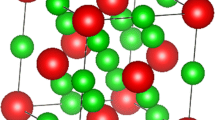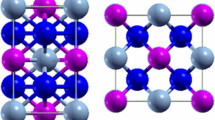Abstract
Structural and magnetic properties of bcc, fcc, and hep Fe and Mn are calculated by use of the generalized gradient approximation (GGA) proposed by Perdew and Wang. For both metals calculated results reproduce most of relevant cohesive properties found experimentally. For example, the pressure induced hcp-bcc phase transition of Fe can be successfully described and an antiferromagnetic ground state is predicted for the fcc structure of Mn with lattice constant and magnetic moment in good agreement with the experiment. Investigation of finite temperature behaviors of bcc, fcc, and hcp Mn by use of quasi-harmonic approximation removes apparent difficulties observed in the calculated results when compared with the experimental facts at high temperature.
Access this chapter
Tax calculation will be finalised at checkout
Purchases are for personal use only
Preview
Unable to display preview. Download preview PDF.
Similar content being viewed by others
References
J.P.Perdew and Y.Wang, Phys. Rev. B 33, 8800 (1986); J.P.Perdew, ibid, 33, 8822 (1986).
P.Bagno, O.Jepsen, and O.Gunnarsson, Phys. Rev. B 40,1997 (1989); D.J.Singh, W.E.Pickett, and H.Krakauer, ibid. 43, 11628 (1991); T.C.Leung, C.T.Chan, and B.N.Harmon, ibid. 44, 2923 (1991).
X.J.Kong, C.T.Chan, K.M.Ho, and Y.Y.Ye, Phys. Rev. B 44, 2923 (1991).
B.Barbiellini, E.G.Moroni, and T.Jarlborg, J.Phys.: Condens.Matter 2, 7597 (1990).
D.Meneghetti and S.S.Sidhu, Phys.Rev. 105, 130 (1957); S.C.Abrahams, L.Guttman, and J.S.Kasper, ibid. 127, 2052 (1962).
O.K.Andersen, Phys. Rev. B 12, 3060 (1975); H.L.Skriver, TheLMTOMethod (Springer, Berlin, 1984).
D.D.Koelling and B.N.Harmon, J.Phys.C: Solid State Phys. 10 3107 (1977).
F.D.Murnaghan, Proc.Nat.Acad.Sci. U.S.A. 3, 244 (1944).
H.Danan, A.Harr, and A.J.P.Meyer, J. Appl. Phys. 39, 669 (1968); W.B.Pearson, Handbook of Lattice Spacings and Structures of Metals and Alloys (Pergamon Press, Oxford, 1964).
This sequence is concluded from the pressure-volume phase diagram of Fe by recognizing that the appearance of the bcc-FM phase is due to its large magnetic energy gain.
L.Kaufman, E.V.Clougherty and R.J.Weiss, Acta Met.11, 323 (1961).
D.L.Williamson, S.Bukshpan, and R.Ingalls, Phys.Rev. B 6, 4194 (1972).
C.Abrahams, L.Guttman, and J.S.Kasper, Phys.Rev.127, 2052 (1962); G.Johanson, M.B.McGirr, and D.A.Wheeler, Phys.Rev. B 1 3208 (1970).
U.Gonser, K.Krishel, and S.Nasu, J.Magn.Magn.Mater.15–18, 1145 (1980).
C.S.Wang, B.M.Klein, and H.Krakauer, Phys.Rev.Lett. 54,1852 (1985); J.Kübler, Phys.Lett. 81A, 81 (1981); H.J.F.Jansen, K.B.Hathaway, and A.J.Freeman, Phys.Rev. B 30 6177 (1984).
V.L.Moruzzi, P.M.Marcus, K.Schwarz, and P.Mohn, Phys.Rev. B 34 1784 (1986); V.L.Moruzzi, P.M.Marcus, and J.Kübler, ibid. 39 6957 (1989); M.Podgórny and J.Goniakowski, ibid. 42, 6683 (1990).
H.Hasegawa and D.G.Pettifor, Phys.Rev.Lett. 50,130(1983).
Y.Tsunoda and N.Kunitomi, J. Phys. F: Met. Phys. 18, 1405 (1988).
T.Oguchi and A.J.Freeman, J.Magn.Magn.Mater. 46 L1 (1984).
R.W.G.Wyckoff, CrystalStructure, vol.1 (Wiley, New York, 1963) p.50.
Y.Endoh and Y.Ishikawa, J.Phys.Soc.Japan 30, 1614 (1971).
J.L.Fry, Y.Z.Zhao, N.E.Brener, G.Fuster, and J.Callaway, Phys.Rev.B 36, 868 (1987); V.L.Moruzzi, P.M.Marcus, and P.C.Pattnaik, ibid. 37, 8003 (1988); S.Fujii, S. Ishida, and S.Asano, J.Phys.Soc.Japan 60, 1193 (1991); G.Fuster, N.E.Brener, J.Callaway, J.L.Fry, Y.Z.Zhao, and D.A.Papaconstantopoulos, Phys.Rev.B 38, 423 (1988); V.L.Moruzzi, P.M.Marcus, and J.Kübler, ibid. 39, 6957 (1989); M.Podgórny and J.Goniakowski, ibid. 42, 6683 (1990).
The stability of Mn was dealt with in trend discussions of relative stability based on force theorem calculations. See, e.g., H.Skriver, Phys.Rev.B 31, 1909 (1985).
V.L.Morruzi, J,F,Janak, and K.Schwarz, Phys.Rev.B 37, 790 (1988).
The temperature dependence of F and rws to be shown in Figs. 5 and 6, respectively, will be enhanced if we use B 0 and B′ 0 to be calculated by Eq.(2)..
Author information
Authors and Affiliations
Editor information
Editors and Affiliations
Rights and permissions
Copyright information
© 1993 Springer-Verlag Berlin Heidelberg
About this paper
Cite this paper
Asada, T. (1993). Application of GGA to a Study of Structural and Magnetic Properties of 3d Transition Metals. In: Terakura, K., Akai, H. (eds) Interatomic Potential and Structural Stability. Springer Series in Solid-State Sciences, vol 114. Springer, Berlin, Heidelberg. https://doi.org/10.1007/978-3-642-84968-8_20
Download citation
DOI: https://doi.org/10.1007/978-3-642-84968-8_20
Publisher Name: Springer, Berlin, Heidelberg
Print ISBN: 978-3-642-84970-1
Online ISBN: 978-3-642-84968-8
eBook Packages: Springer Book Archive




